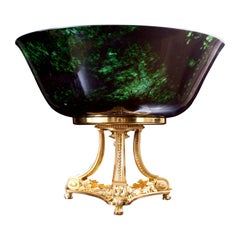Bronze Base With Jade And Candelabra
Antique 18th Century Chinese Qing Decorative Bowls
Jade, Bronze
People Also Browsed
Antique 1890s Chinese Chinese Export Metalwork
Copper, Enamel
Antique Late 19th Century French Art Nouveau Dinner Plates
Ironstone
Antique 16th Century Indian Jewelry Boxes
Silver
Antique 1830s Russian Neoclassical Vases
Malachite, Ormolu, Bronze
1990s English Decorative Boxes
Gold
20th Century English Modern Models and Miniatures
Rock Crystal, Gold Plate, Silver
Antique 19th Century French Louis XVI Dressers
Malachite, Bronze
Antique 17th Century Japanese Edo Lacquer
Copper, Gold
Antique Late 19th Century French Louis XVI Beds and Bed Frames
Ormolu
20th Century Sterling Silver
Sterling Silver
Antique 1830s Chinese Qing Lacquer
Lacquer
Antique Mid-19th Century English High Victorian Taxidermy
Other
Late 20th Century English Modern Animal Sculptures
Stone, Gold, Vermeil
20th Century French Neoclassical Vases
Malachite, Ormolu
Antique Mid-19th Century Russian Other Sterling Silver
Silver, Vermeil
20th Century English Modern Decorative Bowls
Lapis Lazuli, Vermeil
Henri Picard for sale on 1stDibs
Henri Picard was a 19th-century gilder who is said to have graced Paris with his stunning furniture and decor from 1831 to 1864. His bronze pieces included exquisitely detailed candelabras, ornate clocks and sculptural table lamps.
Each item cast and gilded by the talented Picard represented the marriage of function and beauty and is a notable example of Napoleon III-style design. Developing from 1852–70, Napoleon III furniture was plush and ornate, matching the fashion for masked balls and socializing in salons.
Picard was particularly known for his artistry — his body of work includes expertly cast gilt bronze (ormolu) mounts for a range of porcelain vessels produced by Sèvres, a maker of exemplary European ceramics for hundreds of years. Picard collaborated with many designers of his day and worked for a firm called Defreville. And while Picard received numerous commissions, his most notable was designing decorative objects for Napoleon III. The pieces are still displayed at the Napoleon III Apartments in the Louvre Museum, Paris.
Picard also designed mantel clocks for the prestigious French clock-making company Raingo Frères. The manufacturer’s clocks are also on display in the Napoleon III Apartments.
On 1stDibs, find antique Henri Picard decorative objects, lighting, case pieces and more.
A Close Look at Qing Furniture
The last imperial dynasty from 1644 to 1912 was a time of change in China, beginning with the invasion by Manchurian forces that ended the Ming dynasty and established the Shunzhi Emperor. The expansion of exportation and trade that had bolstered the arts during the Ming era continued, as Qing dynasty furniture involved the same attention to craftsmanship with expert construction techniques in hardwood pieces that were assembled with mortise and tenon joints rather than nails or glue. Together, these eras comprise a golden age of Chinese furniture design.
Ming-style furniture is simple and elegant with clean lines. Chairs of the period and other Ming furniture made an impression on Scandinavian modernist Hans Wegner and his streamlined seating, for example. Whereas Qing-style furniture is elaborate, with an increasing influence from the West leading to lavish carving inspired by the European Baroque and Rococo styles. And while many of the forms that define examples of the latter are common within classical Chinese furniture, such as curving and folding chairs as well as large screens, Qing designs are laden with ornamentation. Frequently, the carved motifs and inlaid designs in mother-of-pearl were auspicious, such as peonies for wealth or dragons for luck. Bats were symbols of happiness in the design of Qing furniture, with one of the characters in the word for bat, bianfu, being a homophone for fu, or “fortune.”
While several types of wood were used in the construction of Qing beds, tables, storage pieces and seating, today’s collectors know that the most prized were the rare rosewoods zitan and huanghuali. They were both sourced from Hainan, China’s largest island, and are marked by a rich luster that occurs naturally, without the application of lacquer or other decorative materials. Many of the most popular woods were imported from southeast Asia, adding to their value. Red sandalwood was also sought after for its durability and connection with Chinese medicine, with some chairs being made for health benefits.
Find a collection of antique Qing tea tables, stools, benches, decorative objects and more furniture on 1stDibs.
Finding the Right Decorative-bowls for You
Vintage, new and antique decorative bowls have been an important part of the home for centuries, although their uses have changed over the years. While functional examples of bowls date back thousands of years, ornamental design on bowls as well as baskets likewise has a rich heritage, from the carved bowls of the Maya to the plaited river-cane baskets of Indigenous people in the Southeast United States.
Decorative objects continue to bring character and art into a space. An outdoor gathering can become a sophisticated garden party with the addition of a few natural-fiber baskets to hold blankets or fruit on a table, as demonstrated in the interior design work by firms such as Alexander Design.
Elsewhere, Richard Haining’s reclaimed wood vases and bowls can express eco-consciousness. Sculptural handmade cast concrete bowls like those made by the Oakland, California–based UMÉ Studio introduce compelling textures to your dining room table.
Minimalist ceramic decorative bowls of varying colors can evoke a feeling of human connectedness through their association with handmade craftsmanship, such as in the rooms envisioned by South African interior designer Kelly Hoppen. And you can elevate any space with ceramic bowls that match the color scheme.
Browse the 1stDibs collection of decorative bowls and explore the endless options available.
